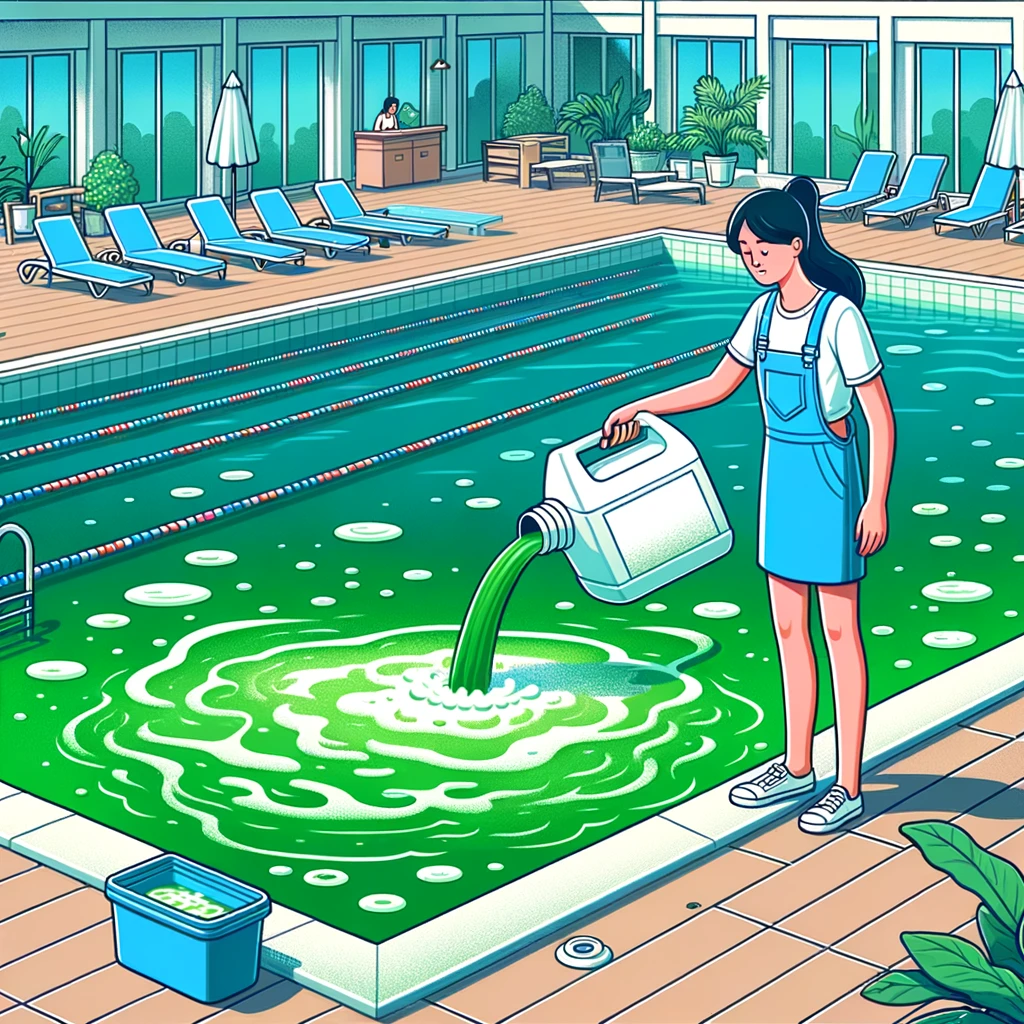Green water in swimming pools is usually caused by algae blooms. The emergence of algae will not only cause turbidity in the water but also adversely affect water quality, thereby posing harm to swimmers. These phenomena occur due to excessive nutrients in the water, inadequate filtration, or insufficient light. It is necessary to fundamentally understand the algae in the water to effectively ensure the cleanliness and safety of the swimming pool water.

1. Carry out algae removal first
The “green” color of swimming pool water is often caused by the growth of algae, making the removal of algae a crucial task. Various types of algaecides are available in the market. The lower-cost copper sulfate utilizes copper ions to kill algae, offering an economical solution that quickly and effectively controls algae growth.
In high-end swimming pools, polyquaternium salts with bactericidal effects are commonly used. This preparation is milder and safer, effectively removing algae without significant staining effects on the water. Compared with copper sulfate, bactericidal and algaecidal agents with polyquaternary ammonium salt as the main component exhibit stronger bactericidal effects, ensuring clear and transparent water.
In addition to chemical agents, physical algae removal is also an effective measure. Enhancing filter efficiency and increasing water flow rate can effectively inhibit algae growth. Additionally, maintaining appropriate light and avoiding direct sunlight helps inhibit algae growth.
2. Add chlorine preparation
After successfully removing algae, the next step is to add chlorine agents, such as dichlorotrichloride, to increase the chlorine level in the water. This type of chlorine-containing agent has strong oxidizing ability, effectively killing residual microorganisms in the water, significantly contributing to maintaining water health and safety. Adding an appropriate amount of chlorine preparations or chlorine tablets to the swimming pool ensures that the microbial content in the water is within a safe range, providing swimmers with a clean and hygienic swimming environment.
In addition, the impact of pH on water quality cannot be ignored. Appropriate pH has a great impact on human comfort and athletes’ health. While removing algae and adding chlorine, it will also have a certain impact on the pH value of the water, so it must be adjusted appropriately. Generally, maintaining water pH can effectively prevent scaling and maximize the sterilizing effect of chlorine.
3. Add clarifying agent
To further improve water clarity, clarifiers must be added. The clarifier’s function is to wrap microorganisms, algae corpses, dandruff, hair, etc., killed by chlorine, allowing them to condense into larger particles for easy removal by the filtration system.
To maximize the effectiveness of the clarifier, activate the pool’s sand filter circulation system. The sand filter device is a highly efficient filtration system with a very fine sand layer that effectively filters out fine impurities. As water passes through the sand tank, contaminants wrapped in the clarifier are captured and retained, thereby clarifying the water.
For swimming pools without a sand tank system, a precipitant can be used. Precipitant is a large particle that can quickly settle pollutants to the bottom to facilitate adsorption treatment. This step can also effectively eliminate residual microorganisms and other pollutants in the water, improving water clarity.
4. The dosage of each drug
In the process of maintaining swimming pool water quality, the rational use of dosage is crucial for keeping the water clear and ensuring swimmers’ health. For different products and situations, adjust the dosage in a targeted manner to ensure the best effect.
Taking polyquaternium salt as an example, it is usually sufficient to add it once every 5 to 7 days. The preparation has a good algae-inhibiting effect and can better control algae cells in the water over time. Regularly dispensing multiple quaternary ammonium salt algaecidal agents can effectively prevent the growth of algae and play a long-term protective role in the water.
Chlorine-containing disinfectants need to be used every day due to their strong oxidizing and bactericidal effects. This maintains the chlorine content in the water at an appropriate level, ensuring the rapid death of microorganisms and cleanliness and hygiene of the water.
It should be pointed out that algae in outdoor swimming pools can easily break out after rainy days, so the investment in chemical agents should be increased. This is due to the organic matter and nutrients carried by the rain, promoting the rapid growth of algae. It is essential to adjust the dosage of chemicals promptly and strengthen water quality monitoring for handling emergencies, ensuring clear and transparent water.
In summary, although the problem of “green” swimming pools is a challenge, it is not impossible to solve. The key to improving swimming pool quality lies in paying enough attention and taking scientific and effective measures. Regular water quality inspections, maintenance of filtration facilities, and strengthening swimming pool water circulation treatment are crucial steps. However, athletes’ personal hygiene habits and respect for the swimming pool environment must not be ignored.
 Instant
Quote
Instant
Quote Email
Us
Email
Us